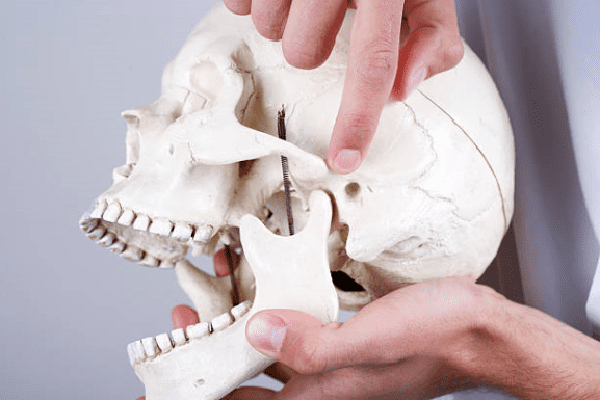Traumatology >>>> Dislocated jaw
Dislocated jaw.

Why does a dislocation of the lower jaw occur?
The lower jaw is attached to the upper jaw and, accordingly, to the skull, due to the temporomandibular joint (TMJ). This is one of the most complex joints in structure, which can perform a variety of movements. Injuries and changes in the structure of the temporomandibular joint inevitably lead to disturbances in the sliding path of the articular head, which often provokes its displacement within the limits that do not allow the articular head to return to its previous position on its own. This is how the dislocation of the joint (or subluxation of the joint) occurs.
Provoke a dislocation of the jaw joint:
- Wide opening of the mouth when yawning, treating teeth, biting off a large piece and many other manipulations that require excessive abduction of the lower jaw;
- Pathological processes that develop with disorders in the endocrine system and are associated with changes in the bone and cartilaginous tissues of the TMJ joint;
- Injuries in accidents and side impacts directly to the jaw (in a fight, during boxing, etc.), forced opening of the mouth in case of convulsive syndrome;
- Prosthetic errors (excessive overestimation or underestimation of the bite), gradually changing the state of the anatomical structure of the TMJ joint;
- Infectious diseases affecting joint tissue;
- Rheumatic diseases that change the movement in the TMJ joint;
- Pathologies of the structure of the TMJ joint itself (poorly expressed articular tubercle, discrepancy between the size and shape of the articular head and fossa, overstretched capsule of the TMJ joint).
Dislocation of the jaw – signs.
Dislocation of the jaw does not always occur in an obvious form - the inability to close the mouth and close the jaws. It can develop as a subluxation of the jaw and be accompanied by unpleasant sensations:
- Crunching and / or clicking when moving the lower jaw,
- Lateral displacement of the jaw at the time of opening or closing the mouth,
- Lack of smooth closing of the jaw and constant search for the position of the lower jaw, which is most convenient for closing the mouth,
- Regular pain symptoms in the TMJ joint,
- An acute attack of pain in the TMJ region at the time of chewing or opening - closing the mouth.
Implicit signs of dislocation or subluxation of the jaw joint can deceptively create the impression that the head hurts in the temples, ear, and occipital region.
Dislocation of the jaw – treatment.
With a clear dislocation of the jaw, when it is impossible to close the mouth and close the jaws, the lower jaw is repositioned. To do this, the dentist wraps the thumbs of both hands with several layers of bandage to avoid injury, puts the thumbs symmetrically on the last chewing teeth of the lower jaw (molars) or as close as possible to the ascending branch of the lower jaw. Presses the jaw, forcing it to move down and then back and up. In this case, it is necessary to quickly remove the hands, since the jaws abruptly close with great force that can injure the doctor's hands. This is a painless procedure for the patient, but requires skill in its execution by the doctor.
Habitual dislocation of the jaw, which does not require difficult reduction, but causes a lot of inconvenience when opening and closing the mouth, it is recommended to treat by installing a limiter for opening the mouth, self-control over the width of the opening of the mouth when yawning, eating or by shortening the ligaments that do not subsequently open wide mouth.
If you experience discomfort in the temporomandibular joint when you open your mouth wide, warn your dentist in advance when visiting a dental office.

Read

Read



























